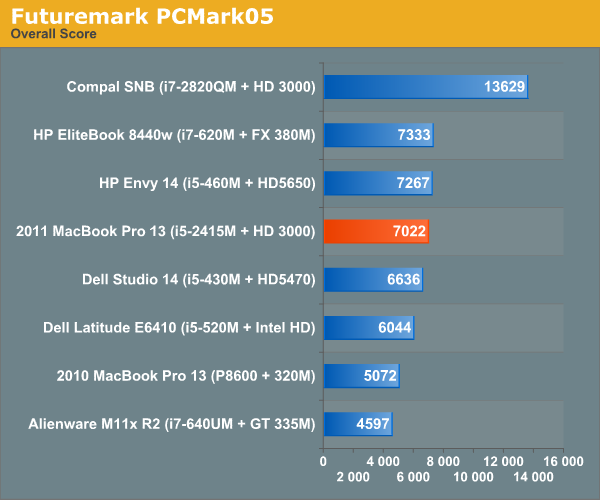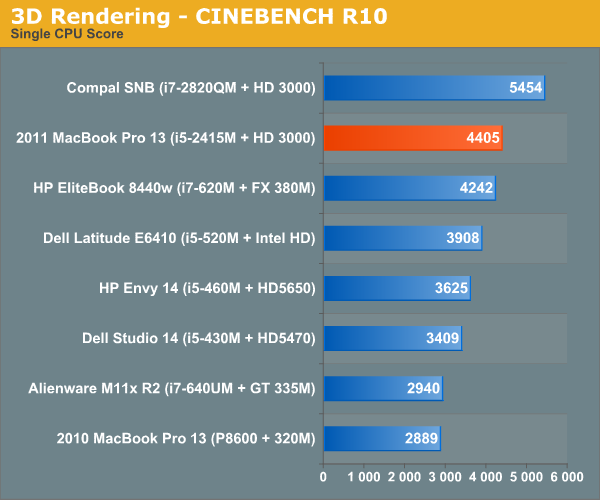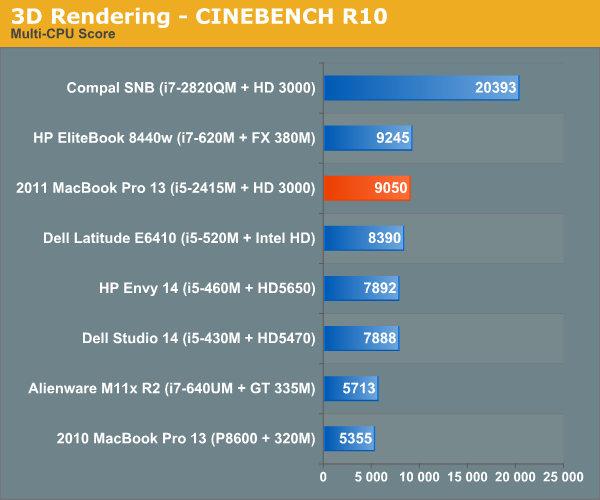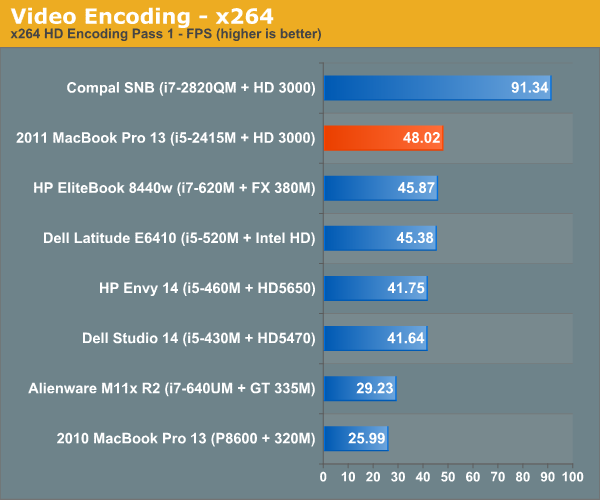The MacBook Pro Review (13 & 15-inch): 2011 Brings Sandy Bridge
by Anand Lal Shimpi, Brian Klug & Vivek Gowri on March 10, 2011 4:17 PM EST- Posted in
- Laptops
- Mac
- Apple
- Intel
- MacBook Pro
- Sandy Bridge
Application Performance in Windows
by Vivek Gowri
In keeping with recent tradition, I'm in charge of evaluating the new MBP under our Windows notebook benchmark suite. Mostly, the MBP works very well as a PC, something I looked at last year with the old 13-inch MacBook Pro. I have the new base 13 in the labs, and I must say, the overall experience is pretty similar...unless you're gaming. But I'll get to that in a minute.
Unlike on the Air I was testing last time around, the Windows install went pretty smoothly thanks to the built-in optical drive. Unfortunately, that's probably going to be the last time I ever use it. And also unlike the Air, there's no problems with storage space here—with the 320GB drive included in the base 13, you have more than enough space for two moderately-sized OS install partitions.
With Windows and Boot Camp drivers out of the way, I fired up our notebook benchmark suite. The new MBP is the first dual core Sandy Bridge notebook we've had in our labs, so I was pretty interested in seeing the performance relative to Arrandale, as well as the old Core 2 Duo-based MBP13. According to CPU-Z, the base spec 13 that I have has the i5-2415M inside, a dual core processor with HyperThreading and clocked at 2.3GHz with max turbo frequency of 2.9GHz. The 2415M is an interesting chip, closely related to the i5-2410M. It's so interesting that Intel doesn't even have a product page for it, which made me curious as to what the difference between the two is. Turns out, the 2415M is the same chip as the 2410M, just in a smaller package. The normal mobile Core i5/i7 processors have a 37.5 x 37.5mm PPGA (plastic pin grid array) package, meant for Socket G2 (also known as rPGA 988B).
The 2415M, on the other hand, has a package size of 31 x 24mm with a micro-FCBGA mounting method. It's the same package size and mounting as the low voltage and ultra-low voltage Sandy Bridge processors, using the same BGA 1023 socket. Apple probably chose the 2415M to make packaging around the processor easier. Smaller is always better in the Apple world.
The other interesting wrinkle here is that Apple has forgone a separate graphics chip for the first time in a very long while. This is the first Apple with Intel graphics since the MacBook's January 2009 refresh brought Nvidia 9400M graphics, and the first MacBook Pro with Intel graphics. Ever.
What does all of this mean for performance? Let's take a look. If you're comparing to the old Core 2 Duo based MBP13, CPU-based performance is almost two times faster across the board. Given the huge jump in power between Core 2 and the further two generations of Core processors, this makes a lot of sense. It was seriously about time that Apple moved on from Core 2 in its smaller notebooks, and this huge performance jump is a direct result. We'll see what happens with the regular MacBook and MacBook Air, but I'd expect a similarly large increase in performance in those models when they're next updated as well.






Looking at the Arrandale-based Core i5-430M, which at 2.26GHz is a logical point of comparison to the i5-2415, we see that performance has improved 15-20%.
This doesn't look as impressive as the gains in performance we saw with our first look at the mobile SNB quad-cores, but Sandy Bridge quads are clocked a lot higher than the preceding Clarksfield chips. Our quad-core SNB mobile testbed had an i7-2820QM, with a 2.3GHz core clock and max turbo frequency of 3.4GHz. The 2820QM replaces the 1.86GHz i7-840QM, so the clock speed is 24% higher. Factor that in, and the increase is more in line with what we saw from the dual-cores.
The big deal here is that now, the lowest end SNB i5 performs roughly on par with the top end Arrandale i7 dual cores. Like Anand said in his Sandy Bridge review, you get yesterday's top of the line performance for a much lower price.










198 Comments
View All Comments
zappb - Saturday, March 12, 2011 - link
Give me a mac book pro with windows 7 as a base install, and id be all over it.Mac OS sucks ass, don't know how anyone can make any money using it. Windows or ill stick to lenovo, would rather send my hard earned dollars to apple but as it stands, not a chance.
bymi - Saturday, March 12, 2011 - link
Hi,thanks for the great review of the new MacBooks!
I googled a lot, but was not able to find a working copy of the MSR Tools used in his article.
Sorry if this hat been discussed before, but i didn't find anything using the search funtionality here.
So where can i get these MSR Tools?
Thank you everybody for a link.
Best
bymi
Ryan Smith - Sunday, March 13, 2011 - link
http://www.insanelymac.com/forum/index.php?showtop...Note that it only works with Snow Leopard booted up in to 32bit mode, as the driver needed to read the MSRs is 32bit.
philipus - Saturday, March 12, 2011 - link
Does anyone know the approximate battery life when using Photoshop (I have CS5) with the dGPU enabled vs disabled?What is the approximate performance drop in Photoshop when not using the dGPU?
These are my main questions before deciding to get the 15" MBP.
Thanks for any insight.
/p
http://philipus.com
fcarnival - Sunday, March 13, 2011 - link
Hello Anandtech, thanks for the Apple's revenue breakdown. Could you also post the profit breakdown of Apple's products? I would like to know which device brings the most profit to Apple. Thanks!macfanpro - Monday, March 14, 2011 - link
I am very curious about this as well - with the tablet market supposedly tripling this year, I want to know what the ramifications are for earnings.Apple has a very nice page with related data (http://www.apple.com/investor/), but alas, I don't think they provide earnings breakdown by product (it's not in their detailed 70+ page annual report)...
amanrai - Monday, March 14, 2011 - link
could you confirm, definitively, whether or not the thunderbolt port will be able to support a discrete pci e based graphics card with or without a HDMI combination?thank you for all of your reviews. they are incredibly detailed and very helpful.
macfanpro - Monday, March 14, 2011 - link
Thanks so much for such an insightful review! I'm trying to rationalize buying a MBP, and I have two questions:Question about power draw) The MBP comes with a 85W adapter, but its maximum power draw is 93.2W. Could this lead to throttling/maximum performance not being achieved even when one is on the adapter?
Question about turbo boost) Some people have reported the turbo boost (for the i7 MBP 13) not working in Boot Camp. (Link: http://www.pcpro.co.uk/blogs/2011/03/10/apple-macb... Do you have any more news on this front?
anaboo - Monday, March 14, 2011 - link
Strong article - appreciate the in depth of benchmarks and insight.I'm hoping you guys can run the same set of in-depth Windows gaming benchmarks on the 15-inch MBP (particularly for the radeon gfx card). Curious to whether there is sub-optimal performance against a similar set of comparables (2010 MBPs, the Mac versions of these games, etc.).
Thanks!
davidglennbailey - Wednesday, March 16, 2011 - link
Best article on the internet on the new Macbook Pros. I'm ordering a 17" Macbook Pro on Friday. Here are my issues.1. Just take the cheap SATA hard drive now and upgrade to a fast SSD in the future when the prices fall a little farther? I will probably void a warranty? How difficult is the process to change one of those out and my chances of screwing something up? How do they even connect inside the machine and how reliable is it?
2. I can understand increased functionality spread out over the life of a product, but even at 3+ years is the .1ghz for 250$ ever worth it? Maybe for the increased cache or any other features?
3. Upgrading the memory was a breeze last time and shouldn't be an issue. Would there be any point or would it be even possible to go above 1333mhz or 8 gigs?
Just to add my 2 cents into the debate. I've had this Macbook Pro for about 5 years. I've put it through hell and back. Sometimes, you just wind up getting what you pay for. Great time to buy if you've been waiting for the quad cores for a while.